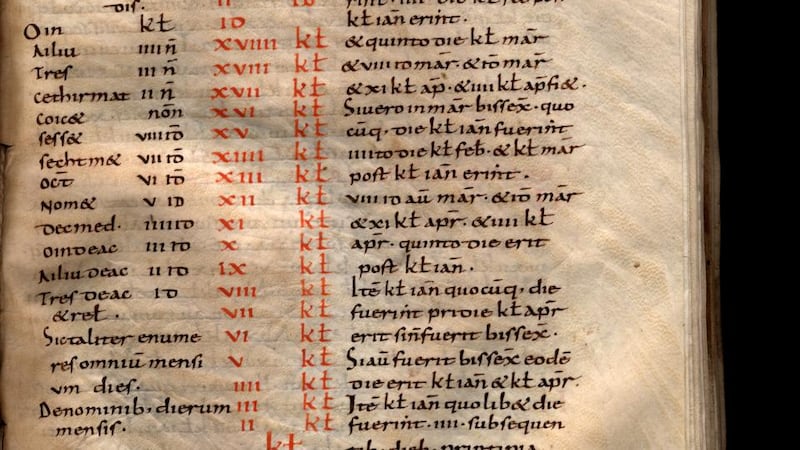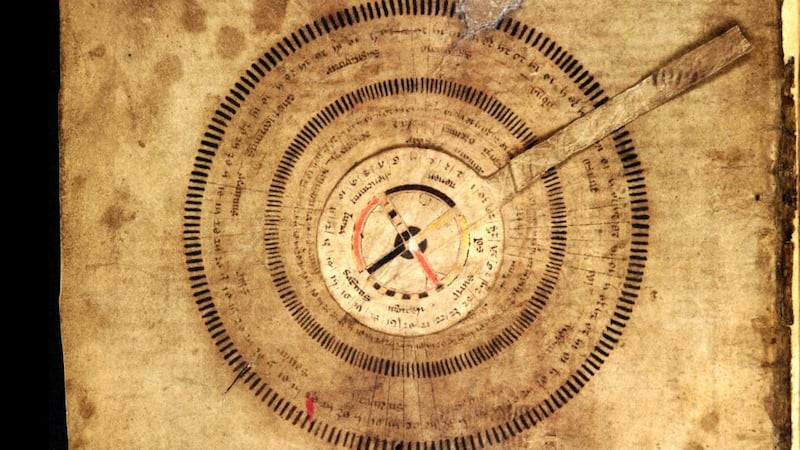Ancient manuscripts show that Ireland was a major centre for the study of mathematics centuries ago. We had some of the foremost practitioners of the fine art of Computus, the difficult business of calculating the date of Easter far into the future.
But the manuscripts, along with later archaeological discoveries, also show the Irish in the eighth century AD were adept engineers, making improvements in technologies used for metal-working and agriculture, and we even had a reputation as boat-builders.
Somehow along the way to modern times, however, we released our grip on this expertise, allowing others to make the breakthroughs and take the lead on the advance of mathematics, science and engineering.


But the manuscripts remain, and they bear witness to our past, something that has been brought back to life in a book launched earlier this week by the Royal Society of Antiquaries of Ireland.
Music and the Stars: Mathematics in Medieval Ireland reveals this past and shows how we were an important contributor to knowledge during the eighth century. The book includes contributions by 12 authors, specialists in the various manuscripts and their meanings, says Mary Kelly, who edited the book with Charles Doherty.
“If you look at the medieval period, we are never mentioned in science. We don’t appear. The work [by the Irish] is appearing in learned journals but is not being incorporated into wider courses at third level,” says Kelly.
Certainly Irish texts on Computus were lodged in Irish monasteries abroad and in the libraries of Germany, France and other countries. But our success in the field, which involved complex mathematics, is not recognised today.
Glendalough manuscript
Kelly became interested when examining a single manuscript page on display at the visitors' centre at Glendalough, Co Wicklow, where she works. It dates from the early 12th century, probably 1106, and is a maths text, and is thought to be a fragment on the use of the abacus, De Abaco, by Gerbert of Aurillac.
Intriguingly, the page of Latin text includes a handwritten note in Irish. The note was in a style called Irish minuscule, saying that it was Pentecost, and mentioning that “Tuathal ua Cathal was ill”. The note then reveals that he had died overnight.
This mix of Latin text and Irish made Kelly curious, so she translated the Latin.
“I started to do research into this. I wanted to know what were the sums and were they right, and what was the standard of education at Glendalough,” she says. “I discovered it was extremely high. The book is advanced maths, mathematical philosophy – much more than one and one is two.”
She broadened her research, looking to assess how much material was available here.
“That is when I discovered there is an enormous history of scientific and mathematical work written in medieval Ireland,” she said. “It came as an enormous shock there was this knowledge and it was not known in the literature.”
The book explains how the monks here were well connected to earlier thinkers, for example the sixth-century philosopher Anicius Manlius Severinus Boëthius and his pivotal work De Institutione Arithmetica – De Institutione Musica. "There is a very lively engagement with mathematics between Ireland and Britain; it is high- level mathematics."
One key area where the Irish came to excel was in Computus, and the Irish monk Cummian, thought to have been based in Munster, was a leading researcher on the subject. “By the early seventh century there are three ways to calculate when Easter occurs. It is the Irish who develop this into an entire new genre of literature on Computus,” Kelly says.
Cummian's expertise was shown in letters dating from 633 between him and the abbot of Iona, Ségéne. Cummian had changed his method for calculating the fall of Easter, breaking away from the method adopted by monasteries founded by Colm Cille and adopting the one used in Rome. This caused Ségéne to accuse Cummian of heresy.
“Cummian knows of 10 methods and [in the letter] he goes through all the details and compares them, and he finds that the system used in Rome was the most reliable. He replies to Iona, saying this is the right method,” says Kelly.
As Gaeilge
The manuscripts described in the book are mostly Latin but some of them revert to Irish. The Einsiedeln monastery in the Swiss Alps holds a manuscript on Computus that dates to the ninth century, but is taken to be a copy of an older, seventh- century Irish manuscript, Kelly says.
“The manuscript is written in Latin but in complicated parts it has embedded Irish where there is a need for detailed explantation. The author of the text has intentionally included Irish, incontrovertible truth it is of Irish origin. We have these beautiful numbers from the Swiss Alps. It is really magic to see these.”
Music and the Stars: Mathematics in Medieval Ireland is in book shops or available from fourcourtspress.ie
BORROW AND ADVANCE: IRISH WATERMILLS
Far from being a technological backwater, Ireland in the sixth century was plugged into all sorts of advances, from watermills and ploughs to padlocks and furnaces.
Some of the new technologies had originally come from the first century, says Charlie Doherty, a retired lecturer and researcher in early Irish history at University College Dublin.
“I was always impressed by the borrowing of technology from the Romans,” he says. “From the time Romans conquered Britain, and from the first century AD, the Irish borrowed a lot of technology. We see this in the artefacts but also in the words that were taken into Irish from Latin.”
The Irish even borrowed the Roman alphabet so they could translate Latin documents and help themselves to the latest devices.
Doherty has studied a number of watermills from the sixth century and has found that there wasn’t a simple copycat approach. “The watermills were highly developed here, and those excavated show that it wasn’t just a matter of blind borrowing; there was adaptation and changed techniques.”
The mills were in widespread use in the 700s. More have been found in Munster than in the rest of Europe, says Doherty.
The early Irish engineers took existing methods and improved them. “These [mill] paddles are sophisticated. In other parts of Europe the paddles were simple squares. Here they were well-turned, and shaped like a modern airplane propellor.”
There was a mill in Co Cork that had two flumes and two separate wheels.
There is also evidence of advanced bridge-building at the time, including over the Shannon at Clonmacnoise, “a massive job”, he says. It was 120m long and five metres wide, and linked to a 2.4km stretch of roadway.










